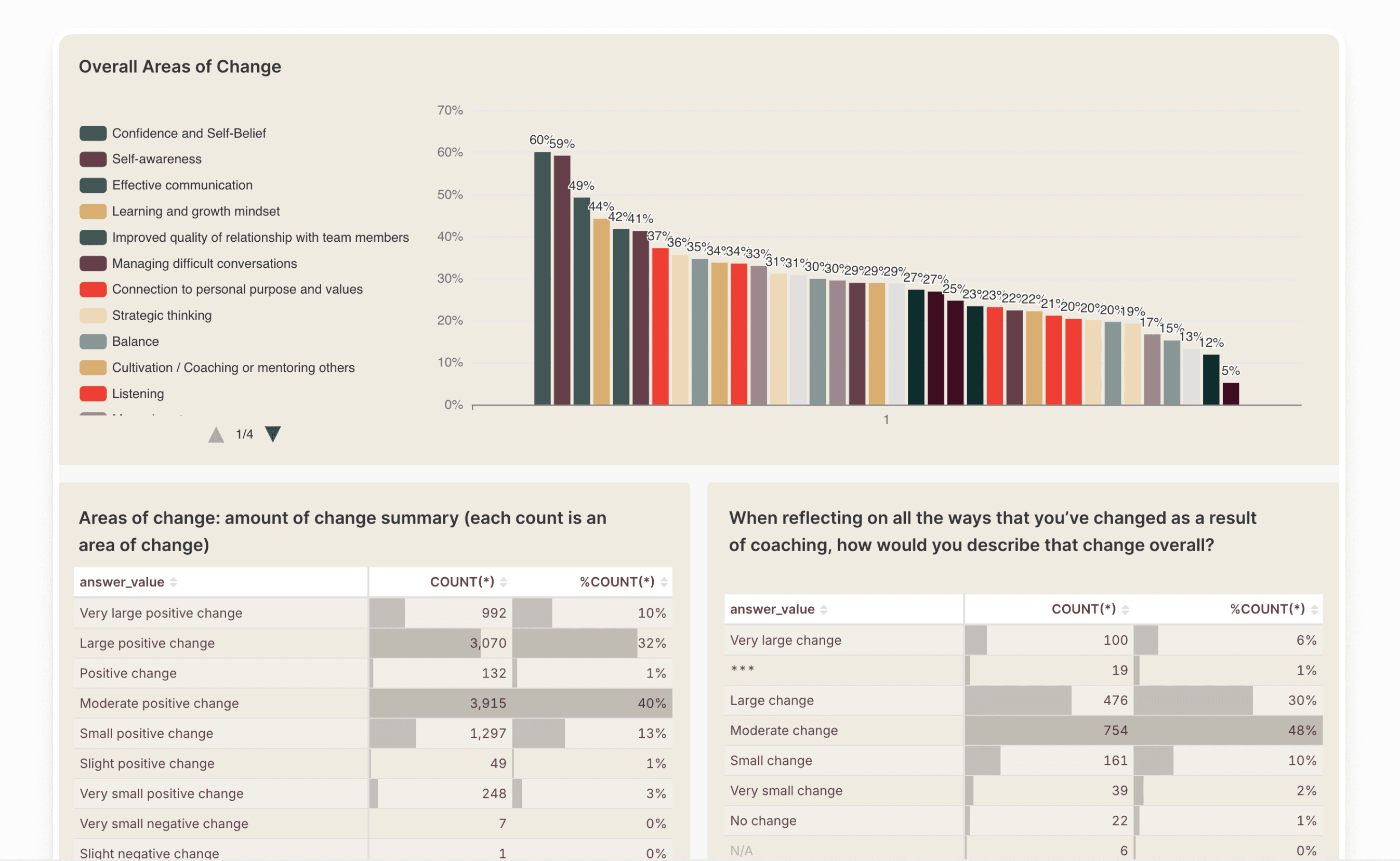Product strategy at Torch
Bye bye, lack of ROI
Torch experienced enterprise customer churn not because coaching lacked impact, but because organizations couldn’t clearly connect individual outcomes to their broader goals. This misalignment created friction during renewal conversations.
Product strategy at Torch
Bye bye, lack of ROI
Torch experienced enterprise customer churn not because coaching lacked impact, but because organizations couldn’t clearly connect individual outcomes to their broader goals. This misalignment created friction during renewal conversations.
Problem space
Undefined success metrics
Nearly 90% of customer accounts lacked clear success criteria, leaving Torch blind to the original goals buyers sought to achieve through their coaching investments.
Open-ended user journeys
Flexible user experiences worked for individual users, but made it hard to articulate business value across organizations.
Disconnected reporting model
Reporting relied on scattered data sources and features, failing to deliver a clear picture of coaching activity or outcomes.
Problem space
Undefined success metrics
Nearly 90% of customer accounts lacked clear success criteria, leaving Torch blind to the original goals buyers sought to achieve through their coaching investments.
Open-ended user journeys
Flexible user experiences worked for individual users, but made it hard to articulate business value across organizations.
Disconnected reporting model
Reporting relied on scattered data sources and features, failing to deliver a clear picture of coaching activity or outcomes.
Team
I worked on this initiative at Torch from Jan 2024–Mar 2025 with

Parker Simon
Lead Product Designer

Julia Calzonetti
Sr. Product Manager

Chloe Li
Sr. Product Designer

Susan Falcone
Dir. of Product & Design

Adam Ingraham
Sr. Product Manager

James Williams
Dir. of Customer Success

Heather Conklin
CEO

Jack Murphy
Engineering Manager

Kate Yesko
Head of Account Management

Catherine Allen
Head of Strategy & Operations

Josh Cohen
Engineering Manager

Mandy Varley
Behavioral Scientist
Team
I worked on this initiative at Torch from Jan 2024–Mar 2025 with

Parker Simon
Lead Product Designer

Julia Calzonetti
Sr. Product Manager

Chloe Li
Sr. Product Designer

Susan Falcone
Dir. of Product & Design

Adam Ingraham
Sr. Product Manager

James Williams
Dir. of Customer Success

Heather Conklin
CEO

Jack Murphy
Engineering Manager

Kate Yesko
Head of Account Management

Catherine Allen
Head of Strategy & Operations

Josh Cohen
Engineering Manager

Mandy Varley
Behavioral Scientist
Solution
An outcome-oriented experience design
User experience
The redesigned coaching experience integrated both individual and company-level priorities with better shared alignment.
Data model
Concepts and language in the data model were revised to more closely align with customers’ desired outcomes.
Stronger value proposition
I reframed customer success messaging to focus on customer goals and align product outcomes with their broader objectives.
Solution
An outcome-oriented experience design
User experience
The redesigned coaching experience integrated both individual and company-level priorities with better shared alignment.
Data model
Concepts and language in the data model were revised to more closely align with customers’ desired outcomes.
Stronger value proposition
I reframed customer success messaging to focus on customer goals and align product outcomes with their broader objectives.
Comparing different user journey models



Comparing different user journey models



Comparing different user journey models



This project is really important. It’s helping the customer see value in their investment. I think this is an invaluable step to making sure everyone is on the same page throughout the duration of the partnership.
L&D buyer at a global fintech
You are incredibly excellent at getting to the root issue… it was a masterful use of coaching to get to what is a real issue vs what feels like a real issue.
Mandy Varley, Behavioral Scientist at Torch
This project is really important. It’s helping the customer see value in their investment. I think this is an invaluable step to making sure everyone is on the same page throughout the duration of the partnership.
L&D buyer at a global fintech
You are incredibly excellent at getting to the root issue… it was a masterful use of coaching to get to what is a real issue vs what feels like a real issue.
Mandy Varley, Behavioral Scientist at Torch
My approach
My approach
Analyzed gaps between the value proposition and the product
I analyzed Torch’s aggregate user data to compare the existing product outcomes against customer expectations and marketing promises.
Analyzed gaps between the value proposition and the product
I analyzed Torch’s aggregate user data to compare the existing product outcomes against customer expectations and marketing promises.


Outcome probabilities across areas of user behavior change resulting from coaching

Outcome probabilities across areas of user behavior change resulting from coaching
Aligned stakeholders around a new product strategy
I highlighted value gaps, outlined strategic changes, and gathered cross-functional support needed to make change happen.
Aligned stakeholders around a new product strategy
I highlighted value gaps, outlined strategic changes, and gathered cross-functional support needed to make change happen.


Early draft of outcome-oriented product architecture

Early draft of outcome-oriented product architecture
Scoped platform-wide design changes
I defined a new product architecture and components to shift the user experience from open-ended to guided with aligned success metrics. Paired with a new coaching data model, this became the foundation for Torch’s “contextual coaching” strategy, which launched in 2025, impacting the participant, coach, and buyer experiences.
Scoped platform-wide design changes
I defined a new product architecture and components to shift the user experience from open-ended to guided with aligned success metrics. Paired with a new coaching data model, this became the foundation for Torch’s “contextual coaching” strategy, which launched in 2025, impacting the participant, coach, and buyer experiences.


Redesigned product architecture that delivered the new strategy

Redesigned product architecture that delivered the new strategy
Impact
Inspired executive rethink of product strategy
With this work, Torch pivoted to a strategy of embedding organizational context into the coaching product, strengthening its market differentiation.
Improved understanding of customer goals
Sales and customer success teams began capturing and integrating customer goals into their processes.
Overhauled the product metrics model
Torch’s leadership team overhauled our coaching data model, replacing generic metrics with relevant, actionable ones aligned with customer goals. We brought it to life by launching six new features and retiring four that no longer delivered value.
Impact
Inspired executive rethink of product strategy
With this work, Torch pivoted to a strategy of embedding organizational context into the coaching product, strengthening its market differentiation.
Improved understanding of customer goals
Sales and customer success teams began capturing and integrating customer goals into their processes.
Overhauled the product metrics model
Torch’s leadership team overhauled our coaching data model, replacing generic metrics with relevant, actionable ones aligned with customer goals. We brought it to life by launching six new features and retiring four that no longer delivered value.


New product strategy and features reflected in refreshed company marketing

New product strategy and features reflected in refreshed company marketing
Challenges and lessons
Objectifying an intangible outcome
Coaching shifts beliefs, behaviors, and communication — changes that are felt, not easily seen. But at scale, what signals success? Coaching buyers often arrived with varying levels of clarity about their goals, making it hard to predictably deliver and measure clear “home run” results. The challenge wasn’t creating impact, but translating human shifts into tangible value at scale.
Exposing a root issue: data model misalignment
In addressing this challenge, we uncovered a deeper problem: the product’s data model wasn’t just disconnected, it was the wrong model entirely. Delivering measurable value required more than new features; it meant redefining the data model itself to align with the product vision and the outcomes we wanted to prove.
Challenges and lessons
Objectifying an intangible outcome
Coaching shifts beliefs, behaviors, and communication — changes that are felt, not easily seen. But at scale, what signals success? Coaching buyers often arrived with varying levels of clarity about their goals, making it hard to predictably deliver and measure clear “home run” results. The challenge wasn’t creating impact, but translating human shifts into tangible value at scale.
Exposing a root issue: data model misalignment
In addressing this challenge, we uncovered a deeper problem: the product’s data model wasn’t just disconnected, it was the wrong model entirely. Delivering measurable value required more than new features; it meant redefining the data model itself to align with the product vision and the outcomes we wanted to prove.